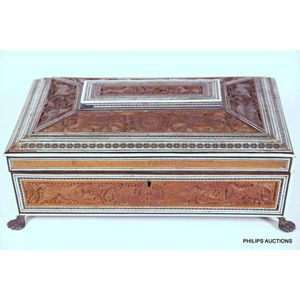19th Century Anglo Indian Mosaic Work Box with Ivory Accessories
You must be a subscriber, and be logged in to view price and dealer details.
Subscribe Now to view actual auction price for this item
When you subscribe, you have the option of setting the currency in which to display prices to $Au, $US, $NZ or Stg.
- Ivory - Ivory is a hard white material that comes from the tusks of elephants, mammoth, walrus and boar, or from the teeth of hippopotamus and whales. The ivory from the African elephant is the most prized source of ivory. Although the mammoth is extinct, tusks are still being unearthed in Russia and offered for sale.
Ivory has been used since the earliest times as a material for sculpture of small items, both in Europe and the east, principally China and Japan.
In Asia ivory has been carved for netsuke, seals, okimono, card cases, fan supports, animals and other figures and even as carved tusks.
In the last 200 years in Europe ivory has been used to carve figures, for elaborate tankards, snuff boxes, cane handles, embroidery and sewing accessories, in jewellery and as inlay on furniture. Its more practical uses include being used for billiard balls, buttons, and a veneers on the top of piano keys.
The use and trade of elephant ivory have become controversial because they have contributed to Due to the decline in elephant populations because of the trade in ivory, the Asian elephant was placed on Appendix One of the Convention on International Trade in Endangered Species (CITES), in 1975, and in January 1990, the African elephant was similarly listed. Under Appendix One, international trade in Asian or African elephant ivory between member countries is forbidden. Unlike trade in elephant tusks, trade in mammoth tusks is legal.
Since the invention of plastics, there have been many attempts to create an artificial ivory - A/f, as Inspected - The letters "A/F" or "as inspected" as part of a description is the cataloguer's shorthand for "all faults" or "as found", meaning the item has some type of damage or deficiency, it is of uncertain date or provenance, and/or that the seller takes no responsibility for the completeness of the item or the accuracy of the description.
This item has been included into following indexes:
Visually similar items

An Anglo-Indian Vizagapatam sandalwood sewing box, mid 19th century, the casket shaped box finely carved in relief with animals and foliate motifs in low relief between bone and sadeli mosaic borders, the complete compartmentalised interior with petite car

Japaned bureau desk fall front bureau with fitted interior above two drawers & two doors, with painted and mother of pearl decoration, 92 cm wide, 107 cm high

Anglo Indian Vizgapatam desk stand, with metal carrying handles, fitted with a lidded compartment flanked by a pair of glass inkwells above a frieze drawer, raised on ivory feet, 29 cm wide approx.

Bone 19th century Anglo Indian writing slope some losses and restoration. Dimensions 38 x 30 x 15 cm
